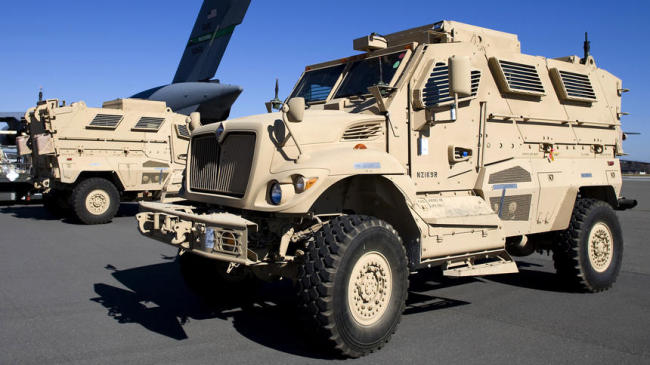U.S. to send 80 mine-resistant vehicles to Korea
Deployment appears aimed at strengthening readiness for possible North Korean instability
By Korea HeraldPublished : Jan. 22, 2014 - 22:00

The Eighth U.S. Army is seeking to deploy more than 80 Mine Resistant Ambush Protected vehicles to South Korea in the coming years in an apparent move to strengthen its preparedness for possible scenarios of North Korean instability.
The EUSA said that pending approval from the U.S. Department of Army, the heavily armored vehicles will be sent from outside Korea to unspecified U.S. military units on the peninsula. Currently, there are no MRAPs in Korea.
“Recognizing the value of MRAPs, the Eighth Army identified an enduring requirement for MRAPs for use in support of both logistics and command and control operations,” the army told The Korea Herald. “Eighth Army continues to work closely with the Department of the Army in the planning, procurement and fielding of more than 80 MRAPs in the coming years.”
The envisioned deployment of the combat vehicles comes after the U.S. Army’s feasibility study in 2012 determined the MRAP was “unsuitable for combined-arms maneuver units” within the 2nd Infantry Division.
According to the U.S. military newspaper Stars and Stripes, the 2nd ID said last August that the vehicles were “not suitable for maneuver battalions to use” in Korea, and that there were no plans to add the MRAP to its fleet in the “foreseeable future.”
“Eighth Army concluded MRAPs provided enhanced capabilities for other Eighth Army units (rather than the Second Infantry Division),” the EUSA said.
The U.S. Army’s pursuit of the vehicles here came as concerns rise over possible instability in the unpredictable state led by the inexperienced dynastic ruler Kim Jong-un. The execution last month of Jang Song-thaek, Kim’s once-powerful uncle, has further worsened the security jitters here and throughout the region.
Apparently mindful of the relentless security threats from the North, the U.S. Forces Korea has been strengthening its deterrence capabilities with a set of new plans for military reinforcements.
The U.S. plans to deploy to the peninsula a dozen F-16 fighters along with 300 troops this month and an 800-strong mechanized infantry battalion next month, both on a rotational basis.
In case of instability in the North, MRAPs would be of great use for U.S. military operations possibly including stabilization activities in the North, as witnessed in battlefields in Iraq and Afghanistan, analysts said.
“In case of a crisis in North Korea, there would be a situation for ground troops to move into the North across the Military Demarcation Line, strewn with a huge amount of land mines. For this, there should be equipment such as the MRAP that could penetrate through it,” said Park Won-gon, a security expert at Handong Global University.
“The possibility of an all-out war remains low for now. But for various scenarios of instability in North Korea, there needs to be such a vehicle to secure routes possibly for North Koreans to move into the South (out of harm’s way) and for those from the South to enter the North.”
Pyongyang has expressed its displeasure over the introduction of MRAPs into South Korea, arguing that the vehicles are intended to mount an attack on it and would aggravate regional tensions.
With its V-shaped hulls, MRAPs served as a centerpiece of U.S. troops’ protection against improvised explosive devices and other bomb attacks during their battle operations in Iraq and Afghanistan.
After more than a decade of the warfare, the U.S. Army has been slashing the number of the MRAPs due to high maintenance costs and its strategic calculation that intense ground wars that require U.S. engagement would be unlikely for some time.
By Song Sang-ho (sshluck@heraldcorp.com)
-
Articles by Korea Herald



















![[Today’s K-pop] Treasure to publish magazine for debut anniversary](http://res.heraldm.com/phpwas/restmb_idxmake.php?idx=642&simg=/content/image/2024/07/26/20240726050551_0.jpg&u=)